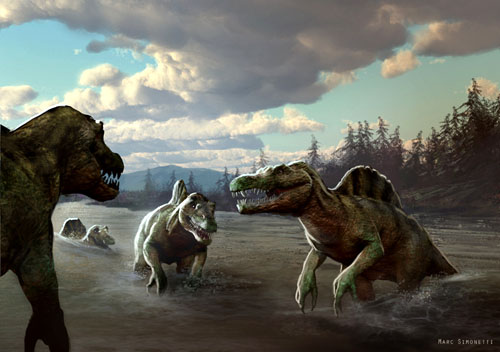Oxygen isotope reveals semi-aquatic habits among spinosaurid theropods for the first time
Spinosaurs were large theropod dinosaurs showing peculiar specializations, including somewhat crocodile-like elongate jaws and conical teeth. Their biology has been much discussed, and a piscivorous diet has been suggested on the basis of jaw as well as tooth morphology and stomach contents. Although fish eating has been considered plausible, an aquatic or semiaquatic lifestyle has seldom been suggested because of the apparent lack of corresponding adaptations in the postcranial skeleton of spinosaurs, which on the whole is reminiscent of that of other large terrestrial theropods.

The lifestyle of theropod dinosaurs
Dr. Romain Amiot, a French postdoc fellow who works with Dr. Zhonghe Zhou at Institute of Vertebrate Paleontology and Paleoanthropology, Chinese Academy of Sciences, and his other collaborators, used 109 new and 24 published δ18Op values of tooth enamel from spinosaurs, other theropods, crocodilians, and turtle shell bones to analysis the differences in oxygen isotope compositions. The δ18Op values obtained for spinosaurids were compared with those of associated terrestrial theropods and semiaquatic crocodilians and turtles. The entire data set reveals that theδ18Op values of spinosaurid dinosaurs are 1.3‰ lower than δ18Op values of other coexisting theropods, but not significantly different from δ18Op values of coexisting crocodilians and turtles. In some Moroccan and Tunisian localities, however, spinosaur values are either comparable to those of terrestrial theropods or extend from crocodilian and turtle values to terrestrial theropod values.
On the basis of the oxygen isotopic composition of their phosphatic remains compared with those of coexisting terrestrial theropod dinosaurs and semiaquatic crocodilians and turtles, Dr. Romain Amiot and his collabrators conclude that spinosaurs had semiaquatic lifestyles, i.e., they spent a large part of their daily time in water, like extant crocodilians or hippopotamuses. This result sheds light on niche partitioning between large predatory dinosaurs, since spinosaurs coexisted with other large theropods such as carcharodontosaurids or tyrannosaurids. The likely ichthyophagy and aquatic habits of spinosaurids may have allowed them to coexist with other large theropods by reducing competition for food and territory.
Download attachments: